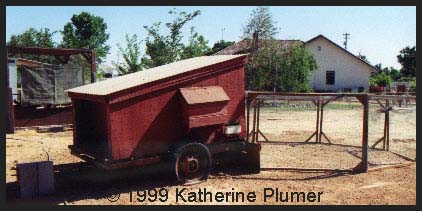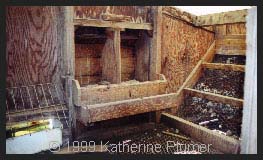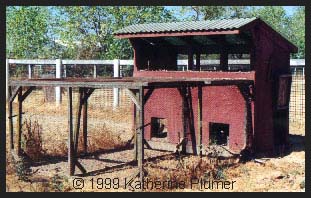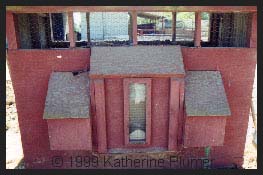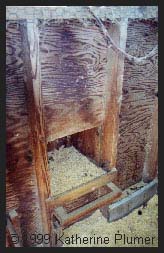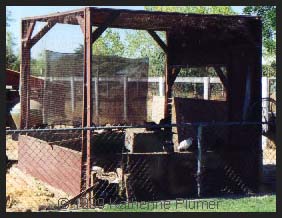 |
|
It is built on an old flat-bed trailer that already had a wire mesh floor, which turned out to be just perfect for large chickens. Food can be poured in from the outside (there's a food-inlet thing where you see that black line on the house over the feed can, that's a rubber flap covering the hinged opening so no rain gets in). The waterer (a metal drawer from an old refrigerator) is usually hooked up to a float and hose, but is not in these pictures because we just moved the house and had not done that yet. The nest box, as seen in the third picture from the top, is accessible from the outside. The outside run is just redwood 2 X 2s with chicken wire, and covered in plastic tree netting to keep the birds in...and out. Theoretically this coop can be moved around, but as you can see by the flat tires, we don't do that very often.
This is a terrible view of the inside, as taken through the door. That's the nest box with two compartments in the center, the roosts in the back of the house, and the waterer up front. All in all this is a very good chicken house, but I would not recommend going out and buying a flat bed trailer. We just happened to have one sitting around. Actually, my mom just told me it was a Model T frame. Who knows. Whatever it is, it works well.
This was our first show chicken house, built in 1987. It housed large Brown Leghorns on one side, and Spangled Old English bantams on the other. Currently it is housing some young Rosecombs that I hope to keep in show-condition.
It is divided in the middle so it can be used at two pens, but can also easily be converted into one pen by moving the waterer which blocks the small opening between the two pens, and by removing the outside panel that divides it in half. The house has a ventilation panel on each side which can be opened in nice weather. That's probably not necessary, but it's cute. It has a wooden floor, and is on 4 by 4 inch wooden "runners" with chains drilled though them so it can be hitched to a truck or tractor and dragged around to move it. The outside panels are 4 feet by 8 feet, covered in chicken wire, and hook onto the house itself (it's hard to see but the top of that outside pen is covered by two panels).
This is the back of the house. That's the feeder in the middle, which goes down into a little trough inside the house. We added the reinforced glass window (part of an old shower door) so that it's quite easy to see how high or low the feed level is without actually opening the feeder. On either side of that is a nest box--one for each side of the house.
Here's another not-so-great photo of the inside, looking towards the back. That's the nest box in the center, and the feed trough in the lower right. The only problems with this coop is it can be difficult to catch the birds that are in here, and with all that open ventilation at the top it can get pretty wet if wind blows the rain in sideways. Other than that it works well.
It can hold a whole lot of young bantams. Mine are in there between 9 and 12 weeks old. It's a weird pen, that's about all I can say about it. Sadly, I lost this pen in early 2004 in a big wind storm. It was just too broken up to fix. May it rest in peace, it served me well.
|
|
copyright © 1999-2011 Katherine Plumer, all rights reserved content may not be used without written permission
|

